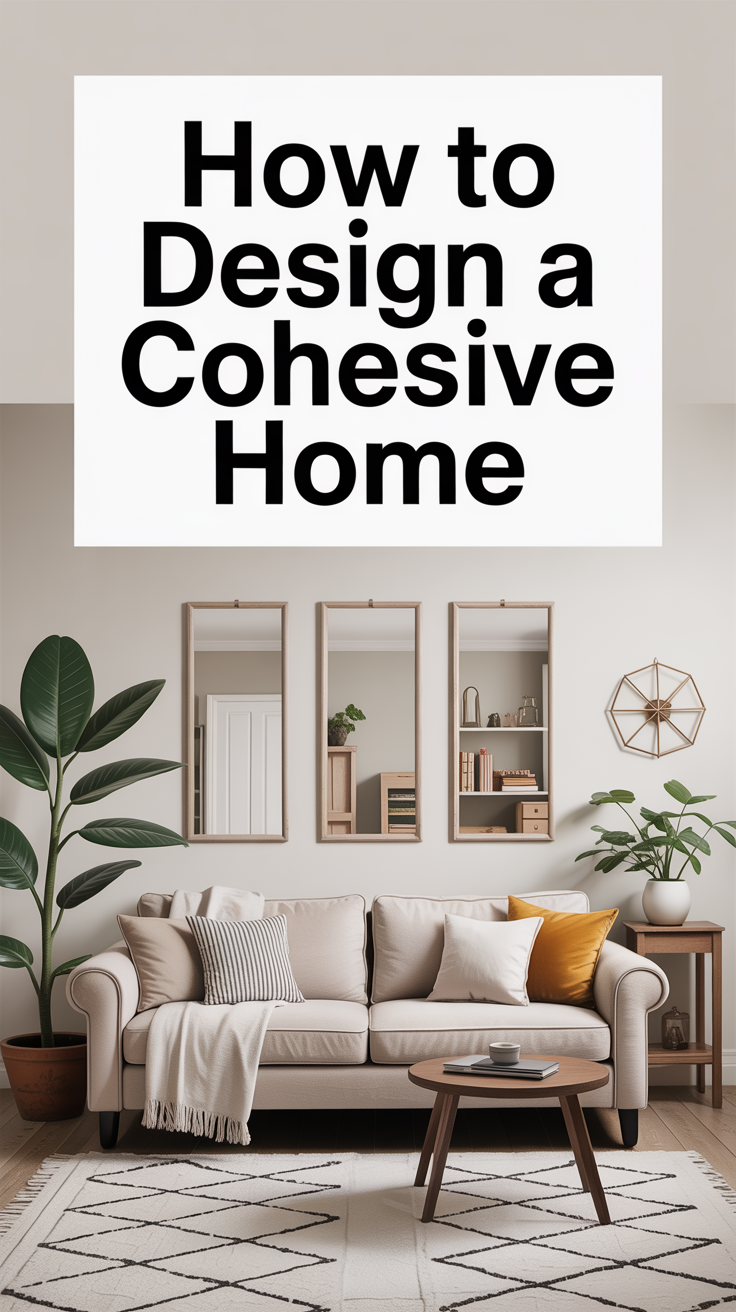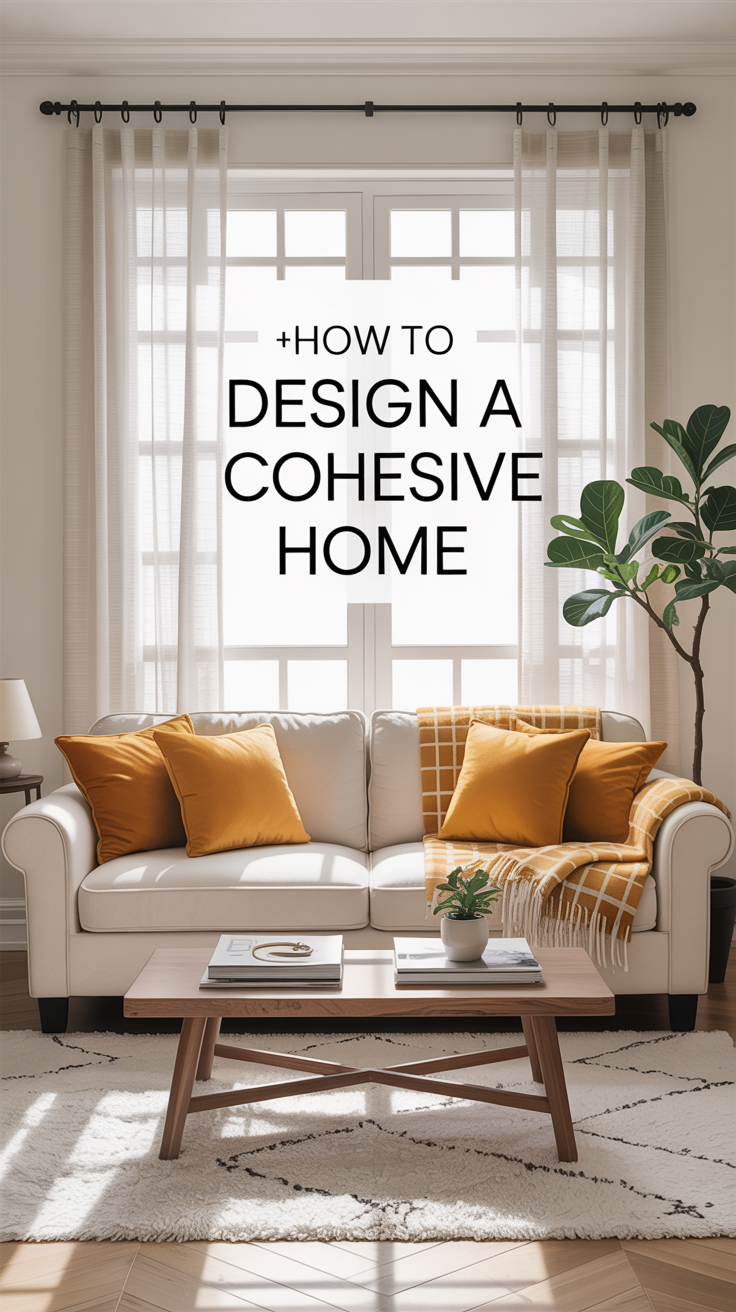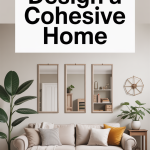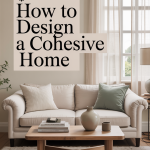How to Design a Cohesive Home That Flows Room to Room
Designing a beautiful home isn’t just about picking furniture you love or choosing a trendy paint color. The secret to creating a space that feels right — where every room connects seamlessly — lies in cohesion. When your home flows from one space to another, it feels intentional, calming, and polished. Without it, even the prettiest rooms can feel disjointed and chaotic.
Whether you’re renovating, decorating a new build, or refreshing a single space, today I want to talk through how to create a harmonious, inviting home that reflects your style — while feeling effortless.

1. Start With a Whole-Home Vision
Before buying furniture or paint, step back and think big-picture. A cohesive home starts with a clear vision of how you want it to feel.
Define Your Vibe
Ask yourself:
-
Do I want my home to feel warm and inviting or crisp and modern?
-
Do I lean toward minimalism or layered, cozy spaces?
-
Am I inspired by nature, luxury resorts, or European charm?
Creating a mood board can help. Collect inspiration photos from Pinterest or Instagram, focusing less on specific furniture and more on mood, texture, and tone.
Pro Tip: Give your style a name. “Modern Organic,” “Coastal Minimalism,” or “Warm Transitional” act as guiding stars when making design choices.
2. Establish a Cohesive Color Palette
Color is the foundation of flow in home design. It’s what ties your spaces together visually.
Pick a Whole-Home Base Color
Choose a neutral base tone that acts as your backdrop — think soft whites, warm beiges, or greige. Use this base color (or subtle variations) on most walls throughout your home.
-
Best Light Neutrals: Swiss Coffee, Chantilly Lace, Simply White
-
Best Warm Neutrals: Accessible Beige, Pale Oak, Natural Cream
This consistency prevents your home from feeling choppy and creates a calming effect.
Layer in 2–3 Accent Colors
Choose two or three complementary accent colors that appear repeatedly in different rooms. You don’t need to match everything perfectly — slight variations keep it interesting.
For example:
-
Base: Warm greige
-
Accent 1: Sage green
-
Accent 2: Black
-
Accent 3: Soft clay terracotta
You might use sage green on pillows in the living room, kitchen barstools, and a bathroom vanity, tying spaces together subtly.
Pro Tip: Use the 60-30-10 rule:
-
60% → dominant color (walls, big furniture)
-
30% → secondary color (rugs, curtains)
-
10% → accent pops (art, throw pillows)
3. Repeat Materials & Finishes
A cohesive home isn’t just about color — texture and material choices matter just as much.
Stick to 2–3 Core Wood Tones
Mixing too many wood finishes can make your home feel cluttered. Instead, choose two to three wood tones and repeat them across furniture, cabinetry, and flooring.
For example:
-
Light oak floors
-
Medium walnut shelves
-
Black-stained dining chairs
This balance adds depth while maintaining harmony.
Coordinate Metal Finishes
Similarly, limit yourself to one dominant metal (like brushed brass) and one secondary (like matte black). Use them consistently for:
-
Cabinet hardware
-
Light fixtures
-
Faucets
-
Door handles
Pro Tip: If you mix metals, repeat each one at least twice in a room so it looks intentional.
4. Use Flooring to Anchor Your Flow
Your flooring sets the tone for your entire home. Sudden changes in material or color can make spaces feel disconnected.
Keep Main Flooring Consistent
Whenever possible, use the same flooring across main living spaces — like hardwood, LVP, or polished concrete. This creates a natural, unbroken path from room to room.
Transition Thoughtfully
If you need to change flooring — for example, tile in bathrooms or mudrooms — choose tones that complement the main flooring. Avoid high-contrast transitions that visually “stop” the eye.
Pro Tip: Use rugs strategically to define zones in open-concept layouts without breaking the visual flow.

5. Connect Spaces With Architectural Details
Even subtle architectural cues can unify your home.
Repeat Trim Profiles
Keep baseboards, door casings, and crown molding consistent throughout. This creates a subconscious sense of continuity, even if your décor shifts slightly.
Echo Shapes & Lines
Look for opportunities to repeat:
-
Arches → entryways, mirrors, cabinets
-
Fluted details → kitchen islands, vanities, wall panels
-
Grid patterns → windows, built-ins, interior doors
These recurring shapes give your home a quiet rhythm.
6. Create Flow Through Furniture Choices
Furniture can make or break a cohesive look. Instead of designing each room in isolation, think of how pieces interact visually.
Keep a Consistent Scale
If your living room has oversized lounge chairs but your dining area features delicate café chairs, the mismatch will feel jarring. Choose furniture with similar proportions for a balanced visual weight.
Choose Complementary Styles
Your pieces don’t need to match perfectly — in fact, that can feel flat. Instead, select styles that speak the same design language:
-
Pair a mid-century sofa with a Scandi-inspired dining table → clean lines connect them.
-
Mix a modern kitchen island with traditional pendant lights → repeating colors or metals ties them together.
7. Carry Lighting Consistently
Lighting design is one of the most overlooked ways to create cohesion.
Pick a Lighting “Family”
Choose fixtures that share a common element:
-
Same finish (brass, matte black, chrome)
-
Similar shapes (globes, cones, cylinders)
-
Repeating textures (linen shades, rattan weaves)
This doesn’t mean buying a matching set — instead, look for siblings, not twins.
Use Layered Lighting Everywhere
Consistency isn’t just aesthetic — it’s functional. Incorporate three layers of light in every space:
-
Ambient: Ceiling lights, chandeliers
-
Task: Reading lamps, under-cabinet lights
-
Accent: Sconces, uplighting, picture lights
When every room has balanced lighting, the experience of moving through your home feels seamless.
8. Style With Repeating Décor Elements
Décor is where cohesion becomes visible. The goal isn’t to duplicate, but to echo.
Repeat Textures
If you have:
-
A bouclé chair in the living room → add a bouclé pillow in the bedroom.
-
A woven jute rug in the entryway → incorporate a jute basket in the laundry room.
Use Art Strategically
You don’t need identical pieces, but consider:
-
A consistent frame finish across your gallery walls
-
A shared color story in your prints or paintings
-
Similar subject matter → abstract forms, landscapes, or black-and-white photography
Pro Tip: Group small décor in threes for balance and repeat key colors at least once per room.
9. Design Sightlines Intentionally
Cohesion isn’t just about what’s in each room — it’s about what you see from one room into another.
Align Focal Points
Stand at your front door or living room entry and notice where your eye naturally travels. Then, create a “breadcrumb trail” of visual connection:
-
A statement pendant light visible from the hallway
-
A bold art piece centered in view
-
A repeated color that draws you forward
Keep Visual Clutter Low
If one room is serene and the next is packed with patterns, the contrast can feel chaotic. Balance boldness so the view feels cohesive.
10. Create Flow With Transition Spaces
Hallways, stair landings, and entryways aren’t just in-between zones — they’re bridges between rooms.
Repeat Materials & Colors
Use rugs, runners, or wall treatments that echo nearby rooms. For example:
-
A hallway runner that matches the tone of your living room rug
-
A stair railing in the same metal finish as your kitchen pendants
Style With Purpose
Add small vignettes that hint at the next space:
-
A console table topped with accents pulled from the dining room palette
-
Wall art that introduces a texture you’ll see in the next room
11. Personalize Without Losing Cohesion
A cohesive home shouldn’t feel cookie-cutter — your personality should still shine.
Pick a Signature Element
Choose one design element to repeat intentionally in each space:
-
A favorite paint color
-
A vintage brass finish
-
A recurring pattern (stripes, florals, geometric forms)
Layer in Personal Touches
Display family photos, heirlooms, or souvenirs — but frame them consistently or place them in designated “storytelling zones” so they feel curated, not cluttered.

12. Build a Whole-Home Décor Strategy
Here’s a quick cheat sheet for tying everything together:

13. Common Mistakes That Break Flow
Even beautiful homes can feel disconnected if you fall into these traps:
-
Too many colors → pick fewer and repeat them
-
Overmixing styles → aim for “siblings, not strangers”
-
Inconsistent finishes → unify metals and woods
-
Ignoring scale → oversized furniture next to tiny pieces feels awkward
-
Forgetting transition spaces → hallways and entryways matter, too
14. Test Before You Commit
Cohesion isn’t just theory — test it visually:
-
Lay all your paint swatches, fabric samples, and wood tones together on one board.
-
Use Pinterest boards to see how your picks interact.
-
Try AI-powered visualizers like Houzz or IKEA Kreativ to preview flow virtually.
Designing a cohesive home isn’t about making every room look identical. It’s about creating harmony — repeating colors, textures, and design choices in subtle ways so that your home feels intentional, inviting, and easy to live in.
When done right, your spaces won’t just look beautiful — they’ll feel connected. Moving from the kitchen to the living room to the bedroom will feel effortless, like turning the pages of a well-designed book.
Pro Tip: Start small. Even repeating a single color, wood tone, or fabric texture across three rooms can instantly elevate your home’s flow.
Another Pro Tip: When I’m stuck on a design problem, I like to take pictures. For some reason, I tend have more clarity through the lens of the camera.
Ultimately, a cohesive home isn’t about following rigid rules — it’s about creating a living environment that feels connected, comfortable, and uniquely yours. The goal is for every room to tell its own story while still being part of the same book. When colors echo softly, materials repeat naturally, and sightlines draw you seamlessly forward, your home starts to feel effortless. And that’s the beauty of good design: it doesn’t just look amazing — it makes life inside your home calmer, easier, and more intentional. Take it one decision at a time, trust your instincts, and before you know it, you’ll have a space where everything — and everyone — flows beautifully together.


